Would the acquisition of either Compagnie Financière Richemont SA or the Swatch Group or both companies ever be a possibility in our times?
In considering such a thing, there are two sides to this coin. One is from a financial perspective: what creates the best value for investors of both companies?

And the other is the effect on the luxury watch market and the buyers and collectors of these timepieces. Let’s take look.
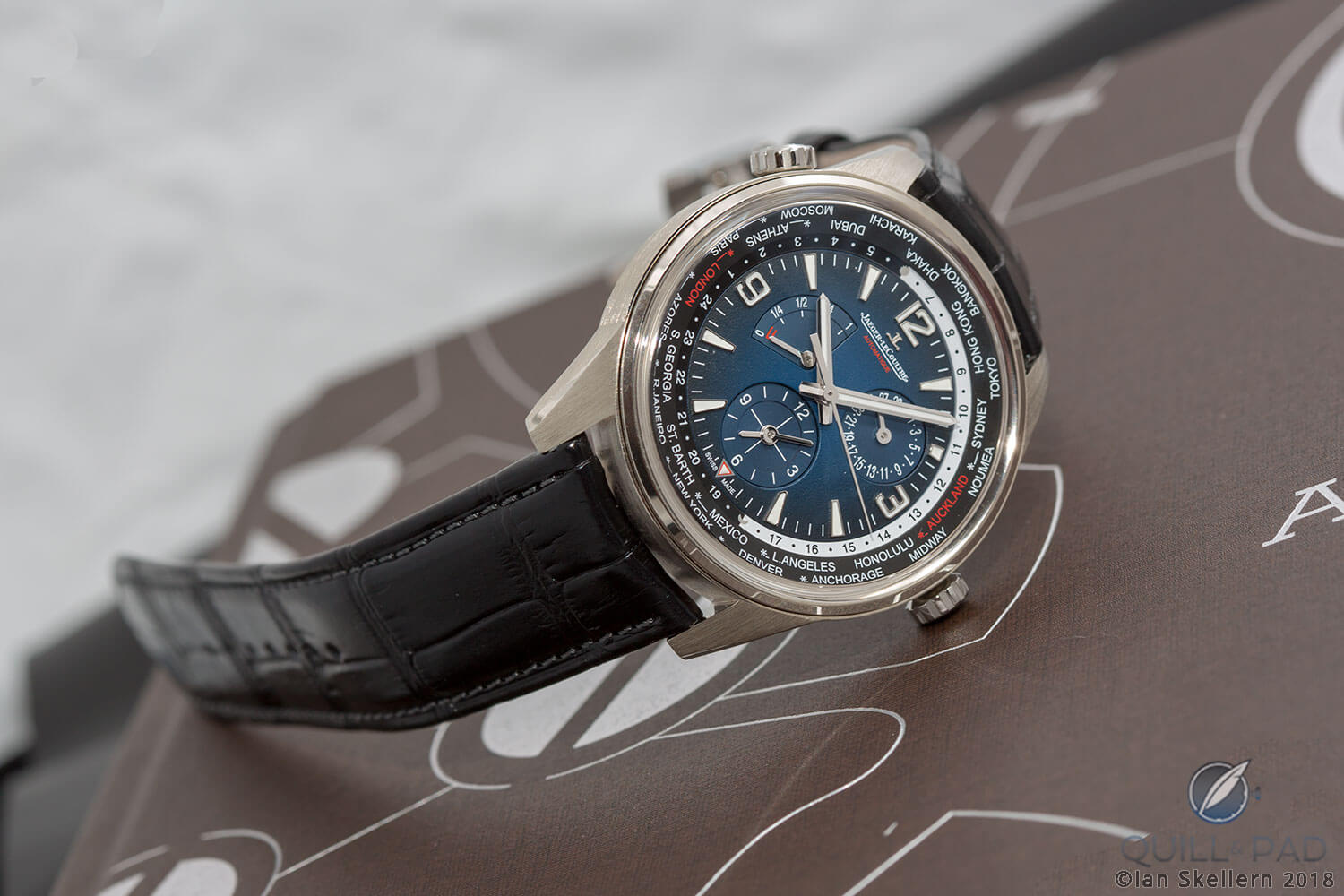
Jaeger-LeCoultre Polaris Geographic WT
Richemont
Richemont owns some of the watch industry’s most iconic brands: A. Lange & Söhne, Jaeger-LeCoultre, Vacheron Constantin, Montblanc, Cartier, IWC Schaffhausen, Officine Panerai, Piaget, Roger Dubuis, and Baume & Mercier among them.
Richemont also owns YNAP (YOOX Net-A-Porter), the go-to online store for a variety of luxury goods.
On the flip side Richemont also owns Watchfinder & Co., an online specialist in the pre-owned watch market.
Both YNAP and Watchfinder cater to different markets, yet there is crossover. At YNAP buyers can get many of Richemont’s brands new, guaranteed authentic, and at a standardized price. Watchfinder provides a credible, trusted outlet for Richemont’s overstock, slow movers, and pre-owned watches, allowing the group the chance to avoid the dreaded grey market discounters.
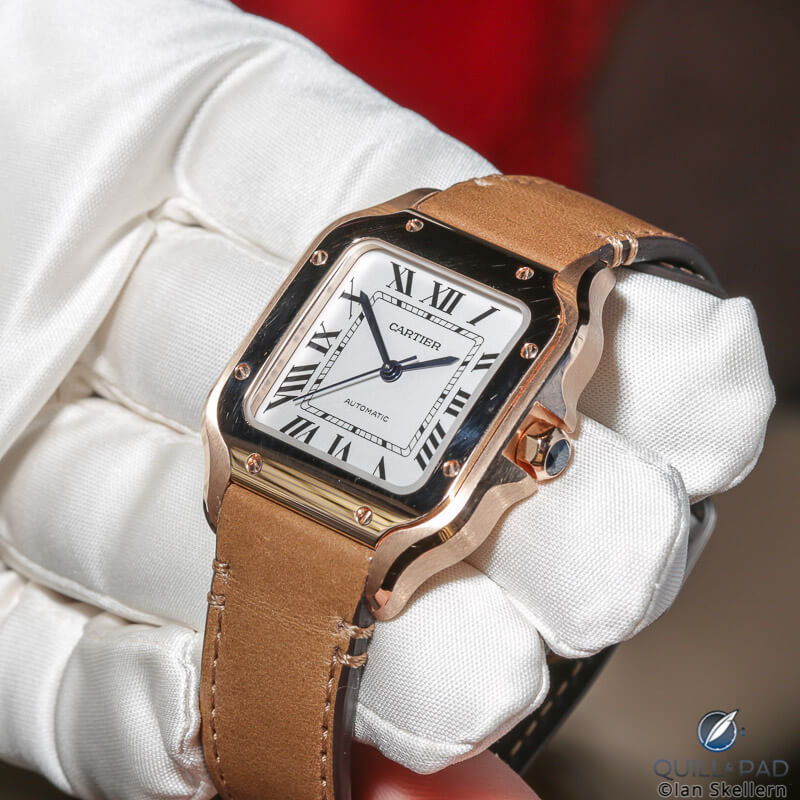
The latest edition of the Cartier Santos
Another point to note about Watchfinder: Richemont has chosen its Vacheron Constantin brand to test blockchain technology in tracking watches, beginning with its Les Collectionneurs line of vintage, pre-owned watches.
If successful, the one-of-a-kind blockchain certification (which cannot be lost, stolen, or forged) could replace paper authentication. This enhances the trust buyers have in working with Watchfinder and further distinguishes Richemont’s pre-owned sales venue. For more on how blockchain is used as a tracking technology, please see How The Watch Industry Is Testing Blockchain And Cryptocurrency.
Yet even with this who’s who of watch brands, Richemont’s stock price hasn’t moved much in the last year – CHF 80 in October 2018 vs. CHF 73.44 on Sept. 23, 2019.
Profits in its watch business and online distributors have been weak. This poor performance reduced the benefit of sales upticks in China and the United States. The analysts’ one-year price target of just CHF 75.03 makes investors wince.
Richemont’s sales for the 2018 fiscal year were €13.9 billion with profits of €2.8 billion. This yielded earnings per share of €4.93.
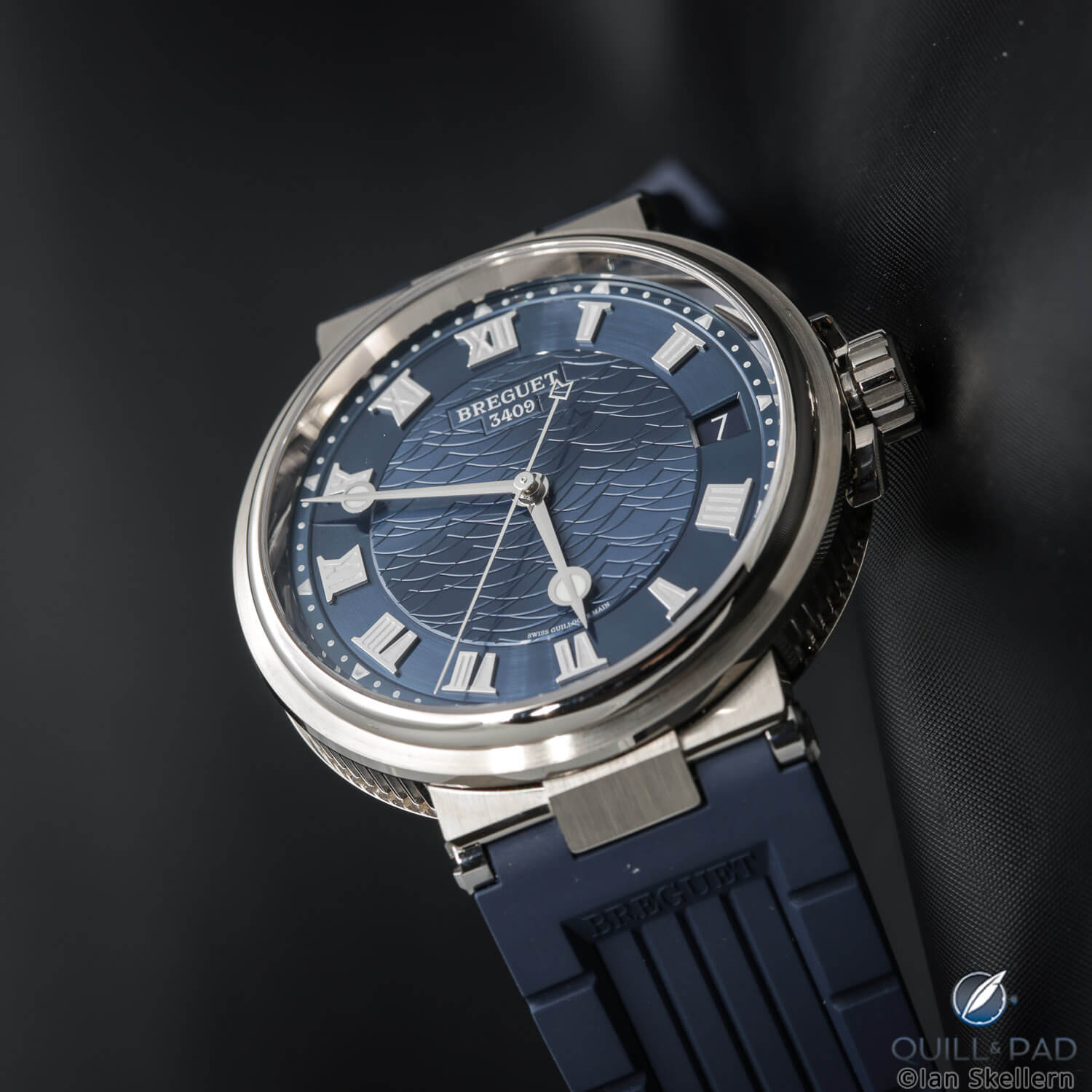
Breguet Marine Chronographe Reference 5527
Swatch Group
Swatch Group designs, manufactures, and sells finished watches, jewelry, watch movements, and components worldwide.
Its flagship brands are nothing to be trifled with, including Breguet, Jaquet Droz, Harry Winston, Blancpain, Glashütte Original, Omega, Longines, Rado, and of course Swatch among others.
Swatch Group employs a vertical integration strategy, making many of its watch components at company-owned facilities. Its Electronic Systems segment designs, produces, and commercializes electronic components and sports timing equipment.
Swatch Group provides research and development, component manufacture, assembly, administration, logistics and distribution, and customer services for its brands.
The group produces pretty much every single component needed for watch production as well as hard material products such as microelectronics, miniature low-frequency quartz crystals, thin wires, and miniature batteries.
Watches and jewelry comprised 97 percent of Swatch Group’s 2018 CHF 8.5 billion revenue. Net income for that year was CHF 867 million (10.2 percent of net sales). Swatch Group is indeed a smaller company than Richemont.
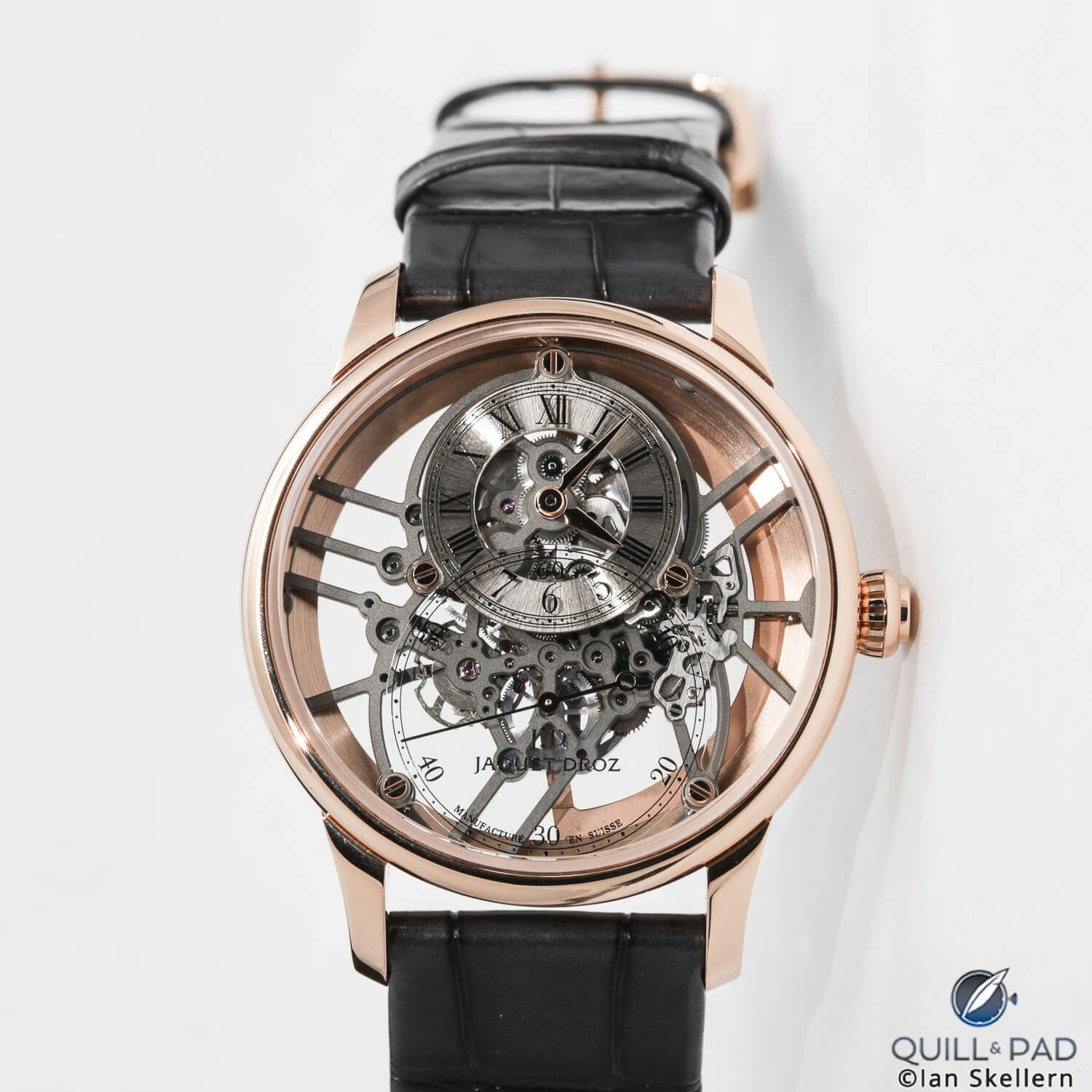
Jaquet Droz Grande Seconde Skelet-One in pink gold
Swatch Group’s stock has fallen considerably over the past year: CHF 390.30 on September 24, 2018, vs. CHF 265.50 one year later.
But would acquisition make sense? And for whom?
Strategic strengths and weaknesses
Assessing the strengths and weaknesses of any target forms the basis for most acquisition decisions. What do they have that we need? Could we buy this strategic advantage at a price lower than we could create it ourselves? What’s the time frame?
Richemont
Richemont’s crown jewels of revenue are Cartier and Van Cleef & Arpels.
Cartier timepieces seem to hold their value over time. The company also enjoys a pricing premium on the brand names and reputations of these two. An acquirer looking for an instant boost to profits from an iconic brand need look no further than Cartier and Van Cleef & Arpels.
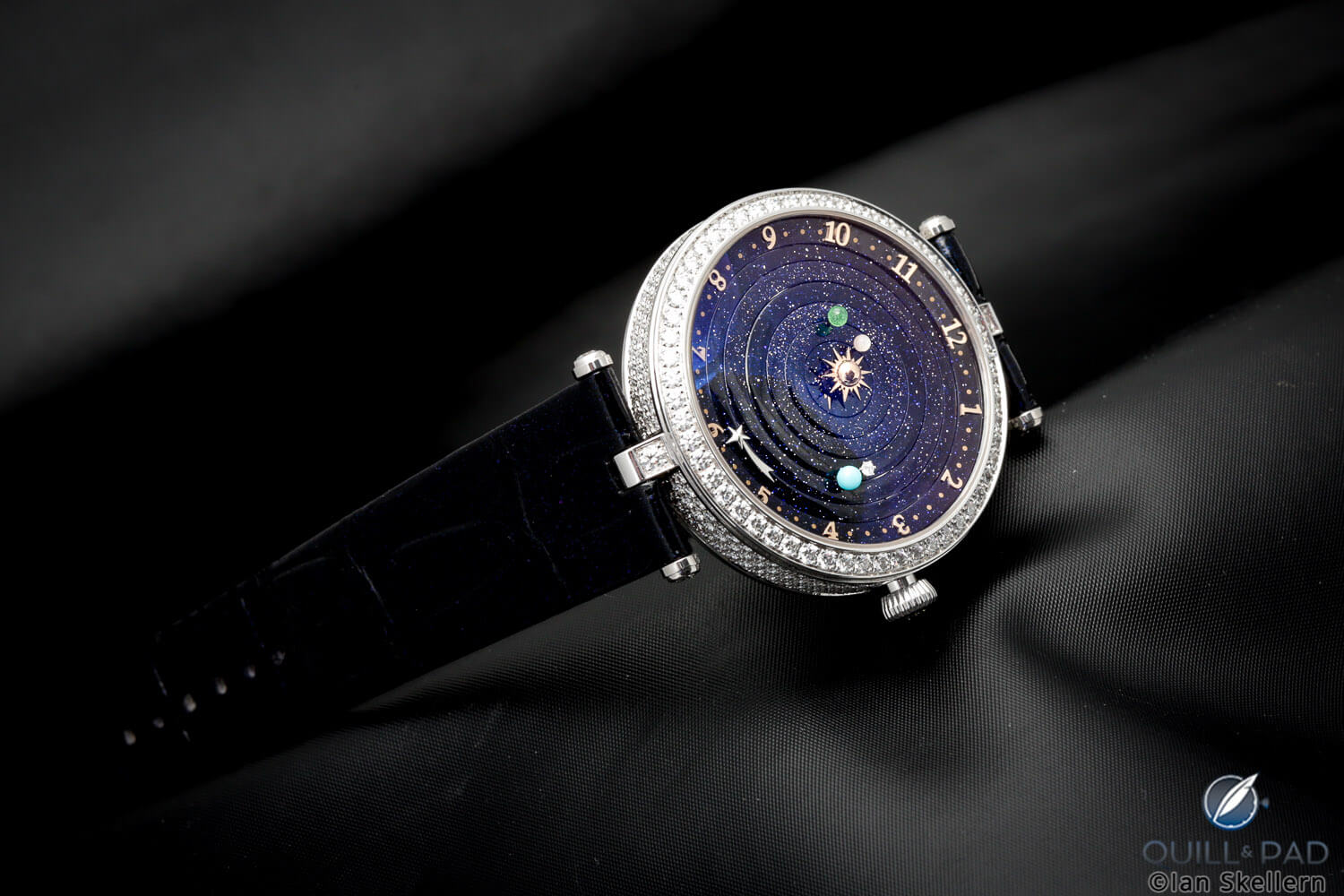
Van Cleef & Arpels Lady Planétarium
Geographic footprint can attract suitors, and Richemont has a significant presence in Asia, the hotbed of luxury goods growth where about 47 percent of the company’s sales are generated. For a company wanting to enter the Asian market for luxury goods, Richemont already has a well-established strategic foothold.
Richemont’s online presence has grown significantly with its acquisition of the remaining 75 percent of YNAP shares it didn’t already own. See more on this in Analysis: Why Is Richemont Buying YOOX Net-A-Porter Group (YNAP) Again?
YNAP provides a significant pipeline for Richemont’s products, including timepieces. For an acquirer needing an instant online presence in the luxury goods space, Richemont’s YNAP subsidiary could make sense.
However, YNAP has many competitors. There is significant online discounting just to move product. This impugns the brand’s luxury status. Some analysts see this squeezing of margins as a race to the bottom for online sellers.
That’s just what happened to Coach leather goods, whose margins shrank to the point they began discounting just to move product. Today Coach is the queen of the discount outlets. How does that support a luxury product image?
Richemont also has a seasoned, standalone management team. This opens the door to financial buyers (vs. strategic buyers) that need to boost their own earnings by acquisition and who know little about what Richemont does. Amazon’s acquisition of Whole Foods is such an example.
Swatch Group
Swatch Group’s iconic watch brands are all well-established within the watch world. However, watches in general are lower-margin businesses unless the brand commands a premium over value of the timepiece. Further, Swatch Group’s business is concentrated almost exclusively in the timekeeping industry, whereas Richemont’s is not.
In addition to traditional retail distribution, Swatch Group markets its products through its own Tourbillon and Hour Passion multibrand watch and jewelry boutiques, monobrand boutiques, and online stores.

The distinctive 1970s look of the Glashütte Original Seventies Chronograph Panorama Date
Swatch Group definitely has an international presence. The company collaborates with myriad international events, just a few of which include the Blancpain GT Series, the Olympic Games (Omega), and professional horse races like the Kentucky Derby (Longines).
As far as name brands with international reach and presence go, though, I’d say Richemont holds the advantage over Swatch Group to an acquirer.
Financial advantages
Bankers have their favorite financial milestones to look at when considering a merger or acquisition. Here are three of mine:
| Richemont (CFR)
(as of 9-30-2018) In € million |
Swatch Group
(as of 6-30-2019) In CHF million |
|
| Cash on hand | 6,535 | 931 |
| Inventory | 6,014 | 7,096 |
| Debt | 4,440 | 22 |
With its huge cash position (€6,535 million), Richemont has considerable dry powder to prosecute an acquisition campaign. If its target was Swatch Group then that company’s minuscule debt (CHF 22 million) could present a significant advantage for Richemont.
Post-acquisition Richemont would float a bond issue with the proceeds paid to themselves to reduce the cash they have on the table. If I were the banker flogging such a deal, I’d insist on the after-acquisition bond issuance. This elevates return on investment and payback period to something that just might be acceptable. After all, Swatch Group is predominately a watch player in an industry with shrinking margins. And, at CHF 265.50, Swatch Group stock is fairly pricey.
Stockholders
Bankers prefer dealing with as few shareholders as possible. Both companies are publicly held. Institutional and mutual fund shareholders are not significant for either company:
- Swatch Group: Gardner Russo & Gardner holds about 3.9 percent of outstanding stock, and three of Vanugard’s mutual funds hold about 2 percent of outstanding stock. Another .5 percent of stock is held by mutual fund company DFA. So less than 5 percent of Swatch Group stock is held by institutions.
- Richemont: Gardner Russo & Gardner, RBO & Co. along with Vanguard combine to hold just 3.6 percent of Richemont’s outstanding stock.
Any consolidation of either company will require a tender offer of shares to the public.
Benefits of an acquisition
If it were between Richemont and Swatch Group, I’d probably look most closely at Richemont purchasing the Swatch Group in its entirety. Here’s why:
- A Richemont-led acquisition of Swatch Group creates the planet’s largest luxury timepiece company. Unless you’re the lead dog, the view never changes.
- The Richemont management team is familiar with M&A and leverage. Both are needed to effectively execute this acquisition.
- The Swatch Group management team is also seasoned and runs a tight ship. They are very familiar with the M&A game. This allows Richemont the luxury of retaining management in place while they integrate Swatch Group into their company and culture.
- Richemont, with its complete ownership of YNAP, has the ability to control supply and pricing of some of the world’s finest watch brands.
- Richemont also owns pre-owned online store Watchfinder. This will benefit the slow-moving Swatch Group brands, keep them off the grey market, and allow them to recoup at least some of their investment in inventory.
- Swatch Group is highly vertically integrated. . . perhaps some Richemont brands could benefit from this technology.
- Cost savings by consolidating operations. Functions such as finance, accounting, marketing, and warehousing are duplicated among both companies. An acquisition could reduce the need for such redundancies and save a ton that goes right to the bottom line.
- Swatch Group is a cleanly run company. The notes to the annual report indicated no material contingent liabilities such as lawsuits. No acquirer wants to buy into trouble.
- With Richemont’s distribution network as well as its online presence through YNAP, there’s an excellent chance acquiring Swatch Group would produce considerable scaling of watch sales.
What about LVMH?
Should Swatch Group ever come into play, Richemont may not be the only suitor; LVMH just might come to the table. The company has a considerable presence in wines and spirits, fashion and leather goods, perfumes and cosmetics, watches (Bulgari, Hublot, TAG Heuer, and Zenith), and jewelry. It even builds some of the world’s finest yachts (Feadship).
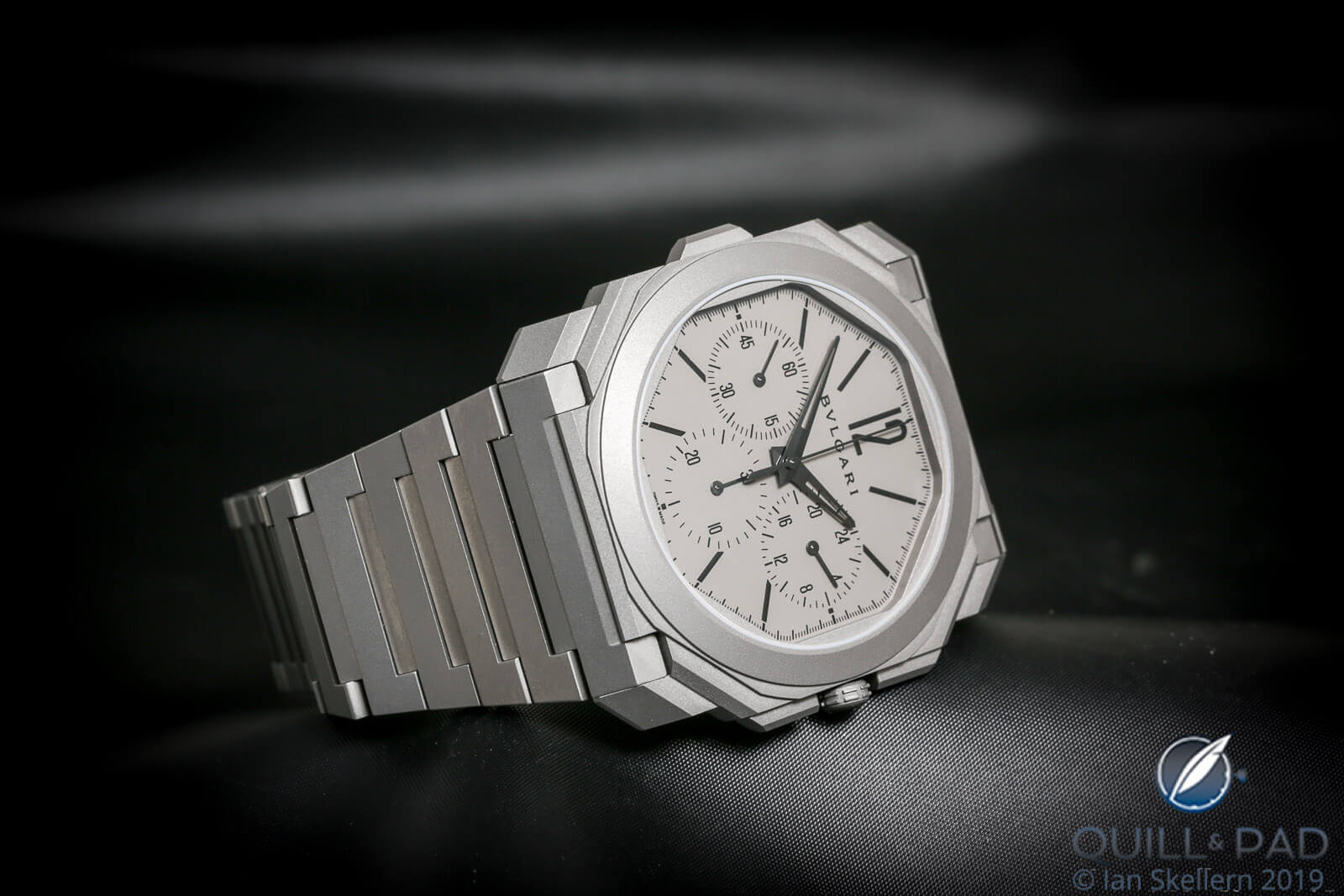
Bulgari Octo Finissimo Chronograph GMT Automatic
With US$4.6 billion in cash and a good credit rating, LVMH has the means to conduct an acquisition campaign. Its stock price hovers around the mid-to-high 70s.
Why not acquire Swatch Group? Its watch brands compliment those LVMH already owns. Indeed, the Swatch Group brands have a more significant market presence and a large presence in Asia. That’s something LVMH can capitalize on since 47 percent of its total revenues come from Asia.
In fact, if I were planning the long-term evolution of the company, I just might begin with a Swatch Group acquisition and see how integration of the company goes. If it works, then let’s make a run at Richemont and become the world’s leading watch owner.
What would this mean to watch buyers?
The answer is a guess. Everyone probably has an opinion. If there ever is a consolidation of most luxury watch brands under a single corporate umbrella, watch collectors and buyers may see some changes.
First, I imagine the grey market would shrink or cease to exist altogether. I’m thinking this because of the online new and pre-owned outlets probably involved in the transaction.
Additionally, both Richemont and LVMH now understand how to preserve a luxury brand’s cache. Currently that involves destroying unsold merchandise rather than discounting it to outlet stores or the grey market. This is a practice I personally find offensive. Much better to sell it elsewhere if possible.
Second, I believe prices just might fall for many brands, especially new watches. They become a commodity. There’s no question they are authentic. Since they’re new, provenance and condition are not issues. The only question is price and availability.
Third, I think we would see some extraordinary new designs coming to market. The corporate parent – whoever it would turn out to be – would have the financial resources to fund new design development initiatives.
I’d like to see what would happen. How about you?
You may also enjoy:
Navigating The Grey Market: A Retail Expert Explains The Whys And Wherefores
Leave a Reply
Want to join the discussion?Feel free to contribute!





















































This article continually references the share price specifically of Swatch as perhaps having a detrimental effect on the possibilities of a merger/acquisition without going into any specifics on company values. For example the below obviously incorrect statement.
“Richemont garners significantly greater revenue than Swatch Group, yet its stock is just CHF 73.44 vs. CHF 265.50 for Swatch Group. The conclusion is that Swatch Group would be quite a bit more expensive to buy than the larger Richemont depending on the number of shares floated.”
This is a common misconception that the share price holds as much importance as to what the real value of the company or price to acquire it, which of course is the market capitalization of the 2 companies. A quick google search will quickly tell you that Richmont is valued at 36 billion CHF while Swatch’s market cap is circa 12 to 13 billion CHF.
The statement that Swatch would be more expensive to buy that Richemont is obviously false. The continual quoting of the share price that frankly has no relevance without the context of the total capitalization is bad journalism. There may be other fallacies/incorrect assertions in this article if something so basic is not understood.
Good point Mark! Couldn’t agree with you more.
A merger seems more likely than an acquisition, perhaps.
To what extent does Swatch Group’s higher share price and lower debt have to do with its ETA division, upon which a large part of the whole industry depends? Although the obligation to supply to anyone ended this year, Richemont itself have a new contract with Swatch to receive ETA parts from next year onwards, and the supply to other manufacturers and microbrands seems to be continuing relatively unabated.
Also, as you’ve pointed out, institutional shareholders hold a very small presence for both companies – do you know how much is owned by insiders?
I know the first comment raises the issue but comparing the price of one share in one company Vs one share of another company as a means of valuation of either perhaps hints that M&A strategy isn’t what you should be writing about.
Mark, Dude, & Colin:
You three are correct. Share price has nothing to do with the intrinsic capitalization value of one company over another. My error entirely. Q&P’s editors and publishers had nothing to do with that. The mistake was all mine.
–Chris
I would not discard the possibility of Rolex coming into the game.
Good observation, Fabio. I don’ttink Rolex would be a financial buyer. So what strategic advantages do you think either company (or both) could provide to Rolex?
—Chris
I love watches.
Keep it uo more and more.